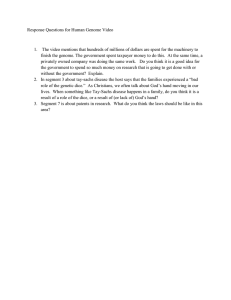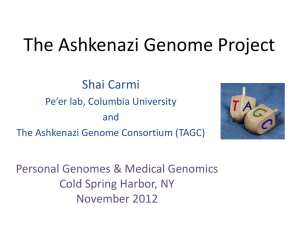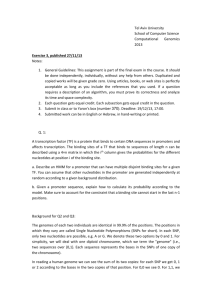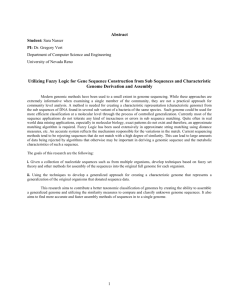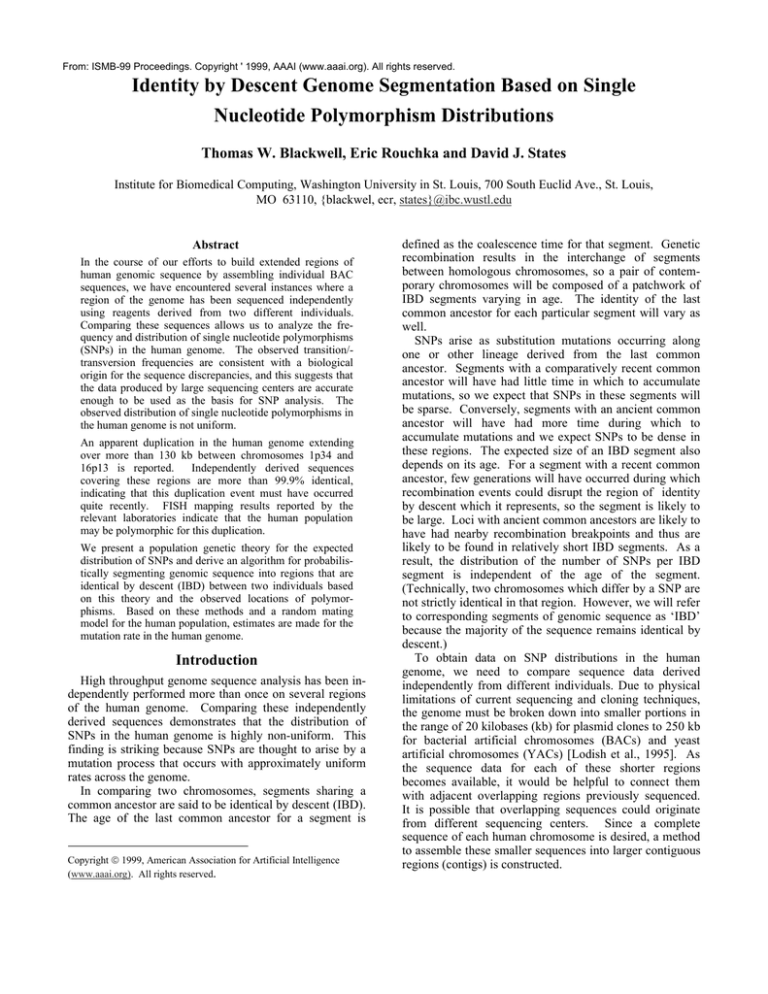
From: ISMB-99 Proceedings. Copyright ' 1999, AAAI (www.aaai.org). All rights reserved.
Identity by Descent Genome Segmentation Based on Single
Nucleotide Polymorphism Distributions
Thomas W. Blackwell, Eric Rouchka and David J. States
Institute for Biomedical Computing, Washington University in St. Louis, 700 South Euclid Ave., St. Louis,
MO 63110, {blackwel, ecr, states}@ibc.wustl.edu
Abstract
In the course of our efforts to build extended regions of
human genomic sequence by assembling individual BAC
sequences, we have encountered several instances where a
region of the genome has been sequenced independently
using reagents derived from two different individuals.
Comparing these sequences allows us to analyze the frequency and distribution of single nucleotide polymorphisms
(SNPs) in the human genome. The observed transition/transversion frequencies are consistent with a biological
origin for the sequence discrepancies, and this suggests that
the data produced by large sequencing centers are accurate
enough to be used as the basis for SNP analysis. The
observed distribution of single nucleotide polymorphisms in
the human genome is not uniform.
An apparent duplication in the human genome extending
over more than 130 kb between chromosomes 1p34 and
16p13 is reported.
Independently derived sequences
covering these regions are more than 99.9% identical,
indicating that this duplication event must have occurred
quite recently. FISH mapping results reported by the
relevant laboratories indicate that the human population
may be polymorphic for this duplication.
We present a population genetic theory for the expected
distribution of SNPs and derive an algorithm for probabilistically segmenting genomic sequence into regions that are
identical by descent (IBD) between two individuals based
on this theory and the observed locations of polymorphisms. Based on these methods and a random mating
model for the human population, estimates are made for the
mutation rate in the human genome.
Introduction
High throughput genome sequence analysis has been independently performed more than once on several regions
of the human genome. Comparing these independently
derived sequences demonstrates that the distribution of
SNPs in the human genome is highly non-uniform. This
finding is striking because SNPs are thought to arise by a
mutation process that occurs with approximately uniform
rates across the genome.
In comparing two chromosomes, segments sharing a
common ancestor are said to be identical by descent (IBD).
The age of the last common ancestor for a segment is
Copyright 1999, American Association for Artificial Intelligence
(www.aaai.org). All rights reserved.
defined as the coalescence time for that segment. Genetic
recombination results in the interchange of segments
between homologous chromosomes, so a pair of contemporary chromosomes will be composed of a patchwork of
IBD segments varying in age. The identity of the last
common ancestor for each particular segment will vary as
well.
SNPs arise as substitution mutations occurring along
one or other lineage derived from the last common
ancestor. Segments with a comparatively recent common
ancestor will have had little time in which to accumulate
mutations, so we expect that SNPs in these segments will
be sparse. Conversely, segments with an ancient common
ancestor will have had more time during which to
accumulate mutations and we expect SNPs to be dense in
these regions. The expected size of an IBD segment also
depends on its age. For a segment with a recent common
ancestor, few generations will have occurred during which
recombination events could disrupt the region of identity
by descent which it represents, so the segment is likely to
be large. Loci with ancient common ancestors are likely to
have had nearby recombination breakpoints and thus are
likely to be found in relatively short IBD segments. As a
result, the distribution of the number of SNPs per IBD
segment is independent of the age of the segment.
(Technically, two chromosomes which differ by a SNP are
not strictly identical in that region. However, we will refer
to corresponding segments of genomic sequence as ‘IBD’
because the majority of the sequence remains identical by
descent.)
To obtain data on SNP distributions in the human
genome, we need to compare sequence data derived
independently from different individuals. Due to physical
limitations of current sequencing and cloning techniques,
the genome must be broken down into smaller portions in
the range of 20 kilobases (kb) for plasmid clones to 250 kb
for bacterial artificial chromosomes (BACs) and yeast
artificial chromosomes (YACs) [Lodish et al., 1995]. As
the sequence data for each of these shorter regions
becomes available, it would be helpful to connect them
with adjacent overlapping regions previously sequenced.
It is possible that overlapping sequences could originate
from different sequencing centers. Since a complete
sequence of each human chromosome is desired, a method
to assemble these smaller sequences into larger contiguous
regions (contigs) is constructed.
Methods
GenBank is used as the reference database for human
genomic DNA used in building the contigs. The results
are based upon release 110.0, which includes sequences
submitted to GenBank up until December 5, 1998 [Benson
et al., 1998]. The GenBank primate division is used in
order to create stable human contigs. In release 110.0, this
is divided into gbpri1, gbpri2, and gbpri3. Table 1 shows a
breakdown of the sequences in the primate divisions by
sequence size.
Sequence length
Number of
(nucleotides)
GenBank entries
> 200,000
72
150,000-199,999
324
100,000-149,999
681
75,000-99,999
340
50,000-74,999
169
25,000 -49,999
1058
TOTAL > 25,000
2,644
Table 1: Length of primate GenBank entries. This table
indicates the number of sequences in the primate divisions
(gbpri1, gbpri2, and gbpri3) of GenBank release 110.0.
Some of the genome sequencing centers incorporate
neighboring clone information into their GenBank entries.
Table 2 shows some examples of how this data is entered
into the comments section. Use of this information could
help in the creation of genome contigs. However, as Table
2 indicates, this data is not standardized among the
sequencing centers. The data is entered by hand in a
manner that is easy for a human to read, but not easily
parsed by a computer. The overlap between two clones, if
given, is present only in a positional manner. An
alignment between two overlapping clones is not given.
We create most of the contigs using an automated
procedure. The first step is to retrieve human sequences
from GenBank which are greater than 25 kb in length.
After these sequences are retrieved their ends are searched
against the primate division of GenBank for overlapping
regions at least 70 base pairs (bp) long and at least 98%
identical. These searches are performed using wu2blastn
version 2.0 [Gish, 1994-1997], the Washington University
version of BLAST [Altschul et al., 1990] with gaps for
nucleic acid sequences.
When overlapping clones are found, they are merged
together into a contig based on the blast alignment.
Discrepancies in the alignment resulting from gaps and
mismatches are marked by the character N in the contig.
After a set of contigs has been assembled, they are
compared against contigs found at the NCBI
[http://www.ncbi.nlm.nih.gov/genome/seq/] and ORNL
[http://compbio.ornl.gov/tools/channel/] web sites. Any
differences are looked at in more detail. As a result of
heuristics used in BLAST, in some cases the reported
highest scoring pairs do not correspond to an optimal
pairwise alignment. In some cases, the heuristic search
and assembly restrictions need to be relaxed for automatic
assembly to occur. Other contigs need to be assembled by
hand in order to create the overlapping region. Since the
volume of sequencing data is growing exponentially, these
steps are largely automated using PERL scripts.
Overlap information
Sequencing center
in COMMENT section
[sample GenBank
accession number]
Sanger Centre
The true right end of clone
[Z99715]
1114G22 is at 104.
The true left end of clone
262D12 is at 51983.
Overlapping Sequences:
University of
Washington Genome 5’: UWGC: g1248a010
(Accession: AC004107)
Sequencing Center
3’: UWGC: g1248a139
[AC004398]
Only 90.0 kilobases from the
Whitehead Institute
middle of this clone are being
for Biomedical
submitted. The remainder
Research
overlaps either accession
[AC005303]
AC003664 (WICGR project
L281) or accession AC005277
(WICGR project L351).
NEIGHBORING SEQUENCE
Washington
INFORMATION:
University Genome
The clone being sequenced to
Sequencing Center
the left is BK085E05; the clone
[AC002378]
being sequenced to the right is
DJ102K02. Actual start of this
clone is at base position 1 of
DJ438O4.
Begining of sequence overlaps
Baylor College of
with AF007262, end of
Medicine
sequence overlaps with
[AC002523]
AF011889.
(Note that Beginning is
misspelled here)
Table 2: Overlapping clone information. The right hand
column contains examples of overlapping clone information
from the COMMENT sections of the GenBank entries
identified in the left column.
The overlapping clone
information is typical for the sequencing centers shown in the
left column.
Difficulties
There are several difficulties with trying to find
overlapping end segments. One problem is that clones
may not overlap with 100% identity due to sequencing
errors and polymorphisms. The PERL scripts are written
in such a manner as to allow overlapping sequences greater
than 98% identical. This allows the possibility that some
overlaps might be missed. Most overlapping segments
should be detected, however, since polymorphisms occur
in the population at a rate of 7/10,000 [Taillon-Miller et
al., 1998], and acceptable sequencing error rates are
1/10,000 [Collins et al., 1998].
Another difficulty is that the end of a sequence may
contain repetitive elements. Prime examples of this are
Alus and LINEs. In these cases, blast will produce
multiple hits to otherwise unrelated sequences. It becomes
hard to determine whether or not two sequences should be
assembled into a contig when the overlap between them
occurs in these repeat regions.
Examples of such
sequences are GenBank accession AC004021, AC004202,
and AC004186.
The length of the overlap also varies greatly. Some
sequencing centers such as Washington University
Genome Sequencing Center (WUGSC) and Sanger Centre
have a relatively constant sequence overlap length for
known overlapping sequences. (In the case for WUGSC it
is 200 bp; for Sanger Centre it is 100 bp.) For the assembled contigs, the size ranges from 0 base pair overlaps
from the Japan Science and Technology Corporation
efforts on chromosome 21 to a 82,766 base pair overlap
between GenBank accession HS326L12 and HS232G24
from the Sanger Centre on chromosome X. Sequences
with less than a 70 base pair overlap were hand assembled.
The GenBank entries for these sequences have been used
to aid in the detection and assembly of these contigs. For
the shorter overlapping segments, running blast to find the
alignment between two sequences takes a matter of
seconds, but for larger regions, the time spent to find the
alignment can take hours.
Generations =>
A theory for SNP distribution in the genome
generations and nucleotides respectively. (These two
continuous approximations are known as a diffusion time
scale and an infinite sites model.)
Locations of
recombination breakpoints and of point mutations are
represented by two independent Poisson processes for each
chromosome in each generation, with rates ρ and µ for
recombination and mutation respectively. Each rate gives
the expected number of events per nucleotide, per
chromosome, per generation.
Consider n = 2 chromosomes chosen at random from
the current day population. It is a standard result
(reviewed in Tavare, 1984; Donnelly and Tavare, 1995)
that at any single locus, the time T to the most recent
common ancestor for these two chromosomes has an
exponential distribution with mean 2 N e generations and
density
1
T
.
f (T | N e ) =
exp −
2N e
2N e
We define the “IBD segment” containing a given locus
to be a maximal region around the locus, within which no
recombination has occurred in the lineage leading to either
of the two sampled chromosomes, in any generation since
their most recent common ancestor. This definition is
specific to the pair of chromosomes in question. By
construction, every site within this segment has the same
coalescence time. If any single nucleotide polymorphisms
are found between the two current day chromosomes
within this segment, they must have arisen by a point
mutation, in one lineage or the other, in some generation
since the time of the most recent common ancestor.
Conditional on the coalescence time T, the length of an
IBD segment has an exponential distribution with mean
1 / 2 ρ T . Marginal over T, this length L has density
4N e ρ
2ρ
f (L | N e , ρ ) =
+
exp(−2 ρ L ) .
2
(1 + 4 N e ρ L ) (1 + 4 N e ρ L )
(This excludes recombinations which might occur during
the current generation.)
Marginal over the segment length, the number of SNPs
occurring in an IBD segment has a geometric distribution
with mean µ / ρ ,
Indi vidua ls
Shown in Figure 1 is a schematic representation for population genetics. Each point along the horizontal line represents
an individual chromosome from the current population. The
jagged line traces the lineage of a particular locus through
preceding generations. The diamond indicates a substitution
mutation which results in a SNP in the current population.
We adopt a neutral Wright-Fisher model for population
genetics. This consists of a random mating population of
constant size with N e diploid individuals and discrete,
non-overlapping generations and no selection. Time into
the past and distance along the chromosome are both
measured as continuous variables, with units of
N
µ ρ
,
Pr( N | ρ , µ ) =
ρ+µ ρ+µ
and is independent of the segment’s coalescence time.
(This is a consequence, rather than an assumption of the
model.) However, conditional on a segment’s length, the
number of SNPs found in it has a modified negative
binomial distribution,
Pr [X ≤ N + 1]
Pr( N | L, N e , ρ , µ ) =
⋅
Pr[Y ≤ 1]
4 N e µL
1 + 4 N (ρ + µ )L
e
N
2
1 + 4 N e ρL
1 + 4 N (ρ + µ )L (N + 1) .
e
5
Here, X and Y are independent Poisson-distributed
random variables with means 2(ρ + µ ) L + 2 N1
and
e
2ρ L +
1
2 Ne
respectively.
Their Poisson cumulative
distributions simply give a convenient representation for
values of the incomplete gamma function. The locations
of the N observed SNPs are uniformly distributed within
the boundaries of the segment, conditional on L and N.
When R is large (~10 ), we introduce an approximation
to further accelerate the calculation. Let r be the resolution
of a segmentation. By this we mean that we will only
consider segment boundaries placed at an integer multiple
of r across the region. In this case, only R/r segment
boundaries need be considered and for each of these, only
R/r possible terminal segments need be considered. The
2
calculation time is then O((R/r) ). Thus, by limiting the
resolution to 10 nucleotides, a factor of 100 improvement
in run time is achieved. In practice, no signficant
difference in results was obtained for resolutions of 10, 20,
50 or 100 nucleotides.
0.3
Results
0.2
Two overlapping clones from different
chromosomes
probability
10,000
100,000
1,000,000
0.1
0
1
10
100
1000
10000
100000
1000000
10000000
100000000
nucleotides
Shown in Figure 2 is the probability distribution for the log of
the IBD segment length for random mating populations of 1
million, 100,000 or 10,000 individuals. The mean IBD
segment length does depend on the population size, and for
all population sizes, the distribution of IBD segment lengths is
extremely broad.
Given a region of the genome containing a number of
SNPs, and some hypothetical segmentation S into intervals
that are IBD, the likelihood for S is calculated as the
product over all segments marginal over all possible
segment coalescence times of the probability that an IBD
segment of that age would have the hypothesized length L
and number of SNPs N at the N observed locations. Thus
the overall segmentation likelihood is just
∞
L( S ) =
∏∫
segments 0
1
Pr ( N | L, T ) f (L | T ) f (T ) dT .
LN
Since we do not have a way of knowing which of the
many possible IBD segmentations describing a region
corresponds to the true genetic history, we marginalize
over all possible IBD segmentations for the region. This is
accomplished using a dynamic programming approach
[Lawrence and Reilly, 1985]. Given a set of all possible
segmentations for a region of length R, to segment a region
of length R+1 we must either extend a terminal segment or
start a new segment. The likelihood of each segment
depends only on its length and SNP content so the problem
is partitionable and dynamic programming can be applied.
Since there are R possible terminal segments ranging in
length from 1 to the full length of the region, the
2
calculation requires linear storage and O(R ) time.
An interesting region occurs between two overlapping
clones originating from two separate chromosomes. The
first entry is GenBank accession AL021921 and the second
entry is GenBank accession U95738. The 135 kb
AL021921 is sequenced by Sanger Centre and is annotated
as 1p36.13. The 171 kb entry U95738 is sequenced by
The Institute for Genome Research (TIGR) and is
annotated as 16p13.11. According to the blast hits,
AL021921 lies completely within U95738 with 100
mismatches, 74 of which are transitions (A<->G; C<->T)
and 26 are transversions. There are also 22 gaps composed
of 123 indel events.
The ratio of transitions to
transversions is consistent with a biological origin for
these sequence discrepancies. On average substitution
mutation is expected to produce twice as many transitions
as transversions [Li et al., 1996] while a random error
process (such as sequencing error) would be expected to
produce a two-fold excess of transversions. We observe
three times as many transitions as transversions.
Interestingly, although these two sequences are 99.9
percent identical, they now appear to have been derived
from different chromosomal locations. The Sanger center
confirms the FISH localization of their clone on
chromosome 1p. The source clone for the longer TIGR
sequence was mapped by FISH at the California Institute
of Technology. That data shows FISH signals on both
chromosomes 1p34 and 16p13 (Figure 3). Together, these
FISH data are consistent with the presence of a duplication
event between chromosomes 1 and 16 occurring so
recently that the human population may be polymorphic
for this duplication. Other possible explanations include
probe contamination or a chimeric BAC. There is no
reason to suspect the former and we are not aware of any
documented examples of chimeric BACs. Further, Pieter
de Jong [personal communication] has surveyed over 400
BACs from the RPCI-11 library looking specifically for
evidence of chimerism and found none.
-750
log segmenation likelihood
-800
-850
Ne = 10 e 5
Ne = 10 e 4
-900
-950
-1000
1.00E-09
1.00E-08
1.00E-07
1.00E-06
mutations per nucleotide per generation
Figure 3: FISH results for GenBank accession U95738. This
FISH image indicates a homology between chromosomes 1
and 16. (Image courtesy of California Institute of Technology) (http://www.tree.caltech.edu/pictures/fish-29B12.jpg).
The distribution of single base polymorphisms across
this 134 Kb interval is shown in Figure 4. The distribution
is highly nonuniform with some intervals spanning 10 Kb
with no polymorphisms at all and other intervals of 100
nucleotides containing multiple SNPs.
1
0
-1
0
20000
40000
60000
80000
100000
120000
140000
Shown in Figure 4 is the distribution of SNPs along the
overlap region between sequences U95738 and AL021921.
Overall this overlap spans 134 kb with 100 sequence
discrepancies (74 transitions and 26 transversions).
The dynamic programming algorithm described above
was used to calculate IBD segmentation likelihoods for all
possible segmentations at a variety of population sizes and
single point substitution rates. In all cases a uniform
population with random mating was assumed. For the
purpose of this analysis, the recombination rate was fixed
8
at one recombination per 10 nucleotides per generation
(one centimorgan equals one megabase). While it is
known that the relationship of genetic to physical distance
varies across the genome and in some locations is even sex
specific, these variations are relatively modest in
comparison to the assumptions we have made about
population size and mating behavior. Results are shown in
Figure 5 below. Calculations were performed with a
resolution (see above) of 10, 20, 50, and 100 nucleotides.
No significant variations with resolution were observed.
Shown in Figure 5 is the calculated likelihood for all possible
IBD segmentations of the U95738/AL021921 overlap as a
function of point substitution mutation rates given a
recombination rate of one per 108 per nucleotide per
generation (one centimorgan equals one megabase) and a
homogeneous population of 100,000 or 10,000 individuals.
The best fit is obtained with a mutation rate moderately in
excess of the recombination rate and a population size of
roughly 10,000.
Discussion
In this paper we present experimental evidence for nonuniform distribution of SNPs across the human genome
and derive theory for the expected distribution of SNPs in
the genome. Interestingly, the observed non-uniform
distribution can be accounted for by the interplay of two
uniform and random processes, single point mutation and
recombination. A striking finding is the very broad
distribution of expected IBD segment lengths and ages.
Another interesting result is that the random number of
SNPs per segment is independent of the IBD segment’s
age.
Given the small number of SNPs that occur, it is not
possible to determine which of the many possible IBD
segmentations corresponds to the true genetic history of
the interval being analyzed. Instead we apply a dynamic
programming approach to calculate the likelihood
marginalized over all possible segmentations of the region.
Using this approach we obtain an approximate estimate for
the point substitution rate in the human genome over the
time to coalescence, roughly a few hundred thousand
years. This estimate depends on knowledge of the
recombination rate, which is well-established from
pedigree genetics, and assumptions about population
structure and history for the human species (reviewed in
Jorde, Bamshad and Rogers, 1998). For assumed population sizes differing by an order of magnitude, the derived
mutation rate differs by a factor of four.
The single point substitution mutation rate estimated
here is in agreement with estimates derived through
pseudogene analysis.
For example, Li et al. have
examined point substitution rates for a number of
pseudogenes identified in primate species. Comparing
human to old world monkey species, they find substitution
rates varying between 0.053 and 0.098 [Li et al., 1996].
These species are thought to have diverged roughly 25
6
million years or 1.25x10 generations ago, assuming a
generation time or 20 years. The corresponding point
-8
substitution rates are 4-8x10 substitutions per nucleotide
per generation.
Our estimate for the human point substitution mutation
rate is independent of many of the assumptions made in
traditional molecular clock calculations. First, we are
calculating the mutation rate with respect to the
recombination rate and therefore do not need to make
assumptions about the average generation time for the
species. Second, the time scale is inferred from the SNP
distribution observed in the genome, and we do not need to
make reference to the fossil record.
Our results suggest that SNPs found in isolation (no
other SNPs in close proximity on the genome) are likely to
have been derived from a relatively recent mutation event
while SNPs found in clusters are more likely to have been
derived from a comparatively ancient ancestor. If there
has been stratification of the human population, the older
SNPs are more likely to be present in all contemporary
branches of the population and thus might be preferred for
use as genetic or diagnostic markers.
Acknowledgments
We wish to thank Brendan Loftus of the TIGR Center
and Andrew King of the Sanger Centre for assistance in reviewing clone origins and FISH data and the Caltech
Genome Center for permission to reproduce Figure 3.
This work was supported by the Department of Energy
under grant DE-FG02-94ER61910 and by the National
Institutes of Health under grant R01 HG01391.
References
Altschul, S.F., Gish, W., Miller, W., Myers, E.W., Lipman,
D.J., (1990) Basic Local Alignment Search Tool. Journal
of Molecular Biology, 215:403-410.
Benson, D.A., Boguski, M.S., Lipman, D.J., Ostell, J.,
Ouellette, B.F., (1998) GenBank. Nucleic Acids Research,
26(1):1-7.
Collins, F.S., Patrinos, A., Jordan, E., Chakravarti, A.,
Gesteland, R., Walters, L., (1998) New Goals for the U.S.
Human Genome Project: 1998-2003. Science, 282(5389):
682-689.
Donnelly, P. and Tavare, S., (1995) Coalescents and
Genealogical Structure Under Neutrality. Annual Review
of Genetics, 29:401-421.
Gish, W., (1994-1997). unpublished.
Jorde, L.B., Bamshad, M. and Rogers, A.R., (1998) Using
Mitochondrial and Nuclear DNA Markers to Reconstruct
Human Evolution. BioEssays, 20(2):126-136.
Lawrence, C.E., Reilly, A.A. (1985) Maximum Likelihood
Estimation of Subsequence Conservation. Journal of
Theoretical Biology, 13(3):425-39.
Li, W.H., Ellsworth, D.L., Krushkal, J., Change, B.H.J.,
and Hewett-Emmett, D. (1996) Rates of Nucleotide
Substitutions in Primates and Rodents and the GenerationTime Effect Hypothesis. Molecular Phylogenetics and
Evolution, 5:182-7.
Lodish, H., Baltimore, D., Berk, A., Zipursky, S.L.,
Matsudaira, P., Darnell, J. (1995).
Molecular Cell
Biology. New York: Scientific American Books.
Taillon-Miller P., Gu Z., Li Q., Hillier L., Kwok P.Y.,
(1998) Overlapping Genomic Sequences: a Treasure Trove
of Single-nucleotide Polymorphisms. Genome Research,
8(7):748-54.
Tavare, S. (1984) Line-of-descent and Genealogical
Processes, and their Applications in Population Genetics
Models. Theoretical Population Biology, 46:119-164.


